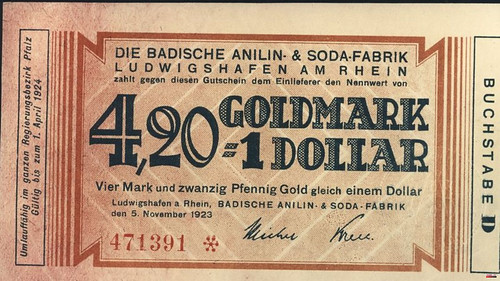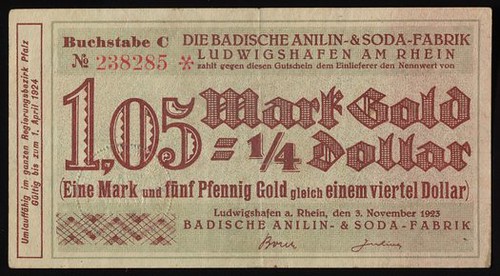
PREV ARTICLE
NEXT ARTICLE
FULL ISSUE
PREV FULL ISSUE
THE ANILINE DOLLARIn November 1923, the German company BASF introduced an emergency currency, the analine dollar. Found via News & Notes from the Society of Paper Money Collectors (Volume IX, Number 22, November 14, 2023). -Editor As a reminder of a difficult time of crisis in Germany, it is now in the BASF corporate archives: the so-called aniline dollar. 100 years ago, in November 1923, the Ludwigshafen company introduced the emergency currency. For a few weeks the aniline dollar became a recognized and popular means of payment in the Palatinate. There are also various emergency coins in the company archives. According to the group, there is no reliable information about the whereabouts of most of the notes. BASF was founded in 1865 as Badische Aniline. At the end of the First World War, Germany was heavily indebted and extremely high inflation put a strain on people. The government allowed companies to produce emergency money to pay wages and maintain trade. The BASF plumbing company began producing blanks from zinc sheet metal. From January 1, 1918 to June 6, 1919, the company issued 64,290 marks to its employees. As security, the management had to deposit 165,000 marks in Prussian treasury notes with the Bavarian State Bank. At the end of 1921 the emergency money was withdrawn, but the problems remained. By 1922, the shortage of paper money had become so severe that BASF was unable to collect enough state funds from the banks to pay wages and salaries. The company was allowed to print its own thousand-mark notes worth 300 million marks. In some cases, emergency money that was already in circulation had to be repeatedly overprinted with higher values ??in the factory print shop. Wages and salaries were secured for a year until the securities transferred to the Reichskreditgesellschaft rapidly lost value. In order to protect its employees from inflation, BASF introduced the so-called Grundmark in September 1923 - retroactive to August 1st - which was finally replaced in November 1923 by a new emergency currency: the aniline dollar. For this, BASF deposited Dutch guilders worth one million US dollars as security - hence the nickname Aniline Dollar. These emergency currencies were produced by the company's own printing house. It was not until November 27, 1923 that the Weimar Republic introduced the so-called Rentenmark, thereby ending inflation in Germany. According to BASF, after 100 years it can no longer be reliably stated how many aniline dollars were printed in total.
To read the complete article, see:
Here's another example. -Editor
For more information, see:
Wayne Homren, Editor The Numismatic Bibliomania Society is a non-profit organization promoting numismatic literature. See our web site at coinbooks.org. To submit items for publication in The E-Sylum, write to the Editor at this address: whomren@gmail.com To subscribe go to: https://my.binhost.com/lists/listinfo/esylum All Rights Reserved. NBS Home Page Contact the NBS webmaster 
|


